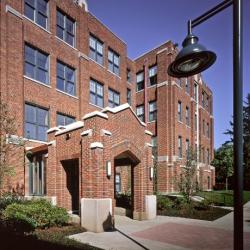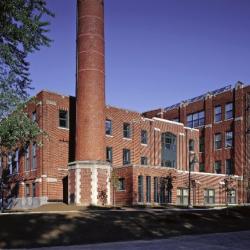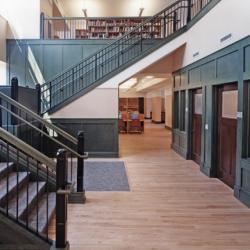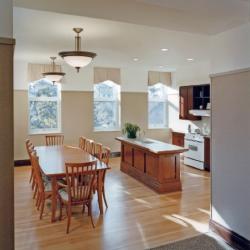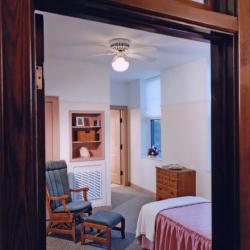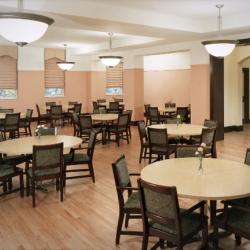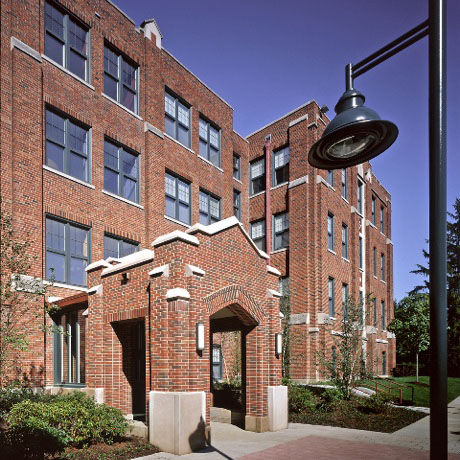
Introduction
The tiny village of Coraopolis, Pennsylvania comprises an area of only 1.36 sq. miles with a population of just 6500. It lies along the Ohio River in suburban Pittsburgh. This project is the story of challenges transformed by design into a model innovative intergenerational community that is both environmentally sustainable and inclusively designed. Starting with the facts of an aging population of a community of Felician nuns, an aging physical plant, rising costs, declining income, the Felician Sisters Convent and Our Lady of the Sacred Heart High School of Coraopolis, Pennsylvania sought to make a lasting legacy through a renovation project that not only demonstrated the benefits of healthy living, but the importance of intergenerational learning. Through full community participation, Perkins Eastman re-configured the 150,000 square foot convent into a sustainable building where Sisters report fewer hospitalizations for upper respiratory illness and “students appear to be happier on a regular basis.”
Description
The Felician Sisters Convent and Sacred Heart High School are located at the top of a hill overlooking Montour Run in a relatively rural area outside Pittsburgh, Pennsylvania. The building consists of over 446 occupants; 64 full-time residents in the Felician ‘Motherhouse,’ 345 high school students and 37 full-time staff members. Additionally, approximately 2,600 visitors tour the site each year. The community originally resided in two buildings, a 1960s infirmary building and a 1930s Motherhouse (Provincial headquarters for the order). As a result of a master planning study, the Sisters decided to renovate the Motherhouse and consolidate the community under one roof instead of relocating.
The building, built with brick and steel characteristic of the area, orients its long façade to the south. With extensive community participation, Perkins Eastman re-configured the 150,000 square feet [13.935 square meters] of convent into ten household clusters of 75 individual rooms with private baths arrayed around a living room, kitchen and dining room.
Four different Halls organize the new school plan and reflect the Felician Order’s ethics: the Hall of Life, the Hall of Social Justice, The Hall of Peace, and the Hall of Community. These Halls are focal points on each of three floors and are used for the presentation of student work and as informal gathering spaces. Intergenerational spaces include a library, chapel, and a public park. Additional community spaces include an auditorium, wellness center, beauty parlor, and several dining areas. Modifications were made to allow greater access to the outdoors. The project was completed in 2003 and awarded LEED Gold certification.
Photos
Main Entrance
Rear View
Shared Space Between Convent and High School
Country Kitchen
Resident Room
Design and the User Experience
The Felician Sisters faced a dilemma. The certain extinction of their community by 2040, an aging physical plant, a population with an average age of 77, declining income, increasing expenses, and the desire to leave a legacy defined the dilemma. The goals of the community were to retain the original character of the building, to support aging in place for the Sisters, to provide a fully accessible building, to be environmentally responsible, to reduce operating costs and to lower maintenance costs.
The existing building plan was not viable. The elderly Sisters’ bedrooms were too far from existing shared bathrooms, which were too small to negotiate for the growing number of sisters using walkers or wheelchairs. The building systems had not been upgraded since the 1930’s. There were no individual temperature controls and the existing partitions contained asbestos.
A leadership team from the Felician Sisters met with the Perkins Eastman design project team throughout design development. The Sisters’ full community came together several times to review the plans and ultimately decided to make a strong commitment to reuse as much of the existing material as possible as an environmentally-friendly renovation. More than 300 original hardwood doors and transoms were refinished and re-hung. More than an acre of hardwood flooring was lifted, cleaned and re-laid. More than a mile of trim was removed, preserved and installed, and over 275,000 pounds of ballast from the roof was stockpiled and reused as underlayment for paving.
The kitchen reused existing materials and provided the Sisters with enhanced living space while the community dining room allows the Sisters double height communal space.
Additionally, several acres of existing lawn were converted to meadowland to promote animal habitats. An accessible outdoor courtyard encourages intergenerational interaction among the students and sisters while serving as a performance area for school productions. Landscaped plantings using native plants provide exterior shading for south and west facades.
Students and visitors arrive at the campus by car or bus transportation. Accommodations for cars, bicycles and other forms of wheeled mobility include surface parking and bicycle racks. The Sisters reduce their impact on the environment with a carpool program. They have a “transportation team” that coordinates the travel needs of the Sisters to take full advantage of carpooling opportunities and minimize the miles traveled per person.
Evaluation
The renovation successfully preserved the original character of the building, supports aging in place for the Sisters, provides a building that not only reduces barriers for residents but adds a variety of features to support independence and quality of life, reflects environmental responsibility, reduces operating costs, and lowered maintenance costs.
When surveyed in a Post-Occupancy Evaluation, the Sister’s community agreed that the building and its green initiatives convey an accurate and appropriate message to the outside world reflecting the Felician Sisters’ commitment to environmental stewardship. The project has been a catalyst for the community: the client has used the renovated building to educate the Sisters, high school students, and staff in environmental issues including green cleaning, recycling, composting, and renewable energy. Significant steps towards environmental stewardship and responsibility were made.
Though electrical costs have increased likely due to the additional lighting and contemporary code-compliant mechanical systems, overall costs for utilities and maintenance have been reduced. Perkins Eastman achieved more than a 30% reduction in energy consumption compared against a baseline model. Systems used to achieve this reduction included heat recovery from air and kitchen exhausts; individual controls in each classroom; landscaped plantings shading the south and west facades; and recycled roof water used in the evaporative cooler. Large openings in the classrooms along with high-reflective paint and Mecho shades provide plenty of controllable natural light.
Meanwhile, the Post-Occupancy Evaluation revealed that the reconfigured living spaces were moderately rated, with some complaints about noise from the television in the living room, a lack of private/quiet places to spend time in, and feeling less of a connection to the Sisterhood (i.e. a perceived loss of overall sense of community) being cited as drawbacks of the renovation. Additionally, it was cited that there are some issues with glare and controlling the amount of light that comes through the window shades and through the transoms.
Overall, the renovation project exemplifies the Sister’s commitment towards environmental sustainability, increased independence and intergenerational learning.
Universal Design Features
- seamless and stepless transition at main entrance which was accomplished through the regarding of the exterior lawn and the creation of a new drop-off area at grade leading to the new vestibule
- easily operable door hardware and door weight
- benches provided for waiting
- fingerprint reader eliminates the need to find and turn a key
- stained glass windows from the Sisters’ chapel filters light and provides a transition between bright daylight and the interior environment
Environmentally Sustainable Features
- three lamp lighting with occupancy sensors
- individual temperature controls
- low-flow fixtures and sensor faucets
- rain barrels
- staged boilers
- reused flooring, trim and doors
- recycled content: carpet, ceramic tile, drywall, structural steel, concrete and ceiling tile
- minimal VOC finishes
- energy efficient window
- water source heat pump loop
Project Details
Location: Coraopolis, PA
Completed: 2003
Client: Felician Sisters Convent and Our Lady of the Sacred Heart School
Design Team: Perkins Eastman
Accessibility Regulations:
Funding: Private
Total Project Cost: $21,841,906
Project Team
Client
Felician Sisters Convent and Our Lady of the Sacred Heart School
Architect
Stefani Danes
Perkins Eastman
Interior Designer
Perkins Eastman
Landscape Designer
Tavis Dockwiller
Viridian Landscape Studio
Contractor
Sota Construction Service
MEP Engineer
Jim Kosinski
Elwood S. Tower Corp
Structural Engineer
Eric Kachele
Kachele Group
Civil Engineer
Dan Deiseroth
Gateway Engineers, Inc.
Materials Reuse Contractors Consultant
Christian Klehm
Clearview Project Services Company
Photographer
Alexander Denmarsh
Denmarsh Photography
Additional information
Awards:
AIA Pittsburgh – Green Citation, 2004
LEED® Gold
AIA/AAHSA Design for Aging Review: Special Recognition (Post Occupancy Evaluation), 2007
Funding By


Propose a Case Study
Help us improve our Case Study library

